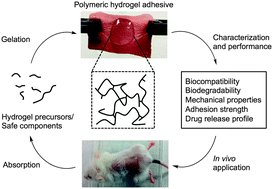The chemistry and engineering of polymeric hydrogel adhesives for wound closure: a tutorial
Abstract
The closure and repair of wounds after traumatic or surgical injury is of significant clinical and research importance. While sutures remain the common wound closure technique, they have many disadvantages. Consequently, polymeric hydrogel adhesives have emerged as essential materials for wound management and repair because of their tunable chemical and physical properties, which enable them to adhere or stick to tissues, possess sufficient mechanical strength to stay intact and be subsequently removed, provide complete wound occlusion, and act as a barrier to bacterial infection. Moreover, these materials absorb wound exudates and keep the wound moist for faster healing. This tutorial review summarizes the key chemical features that enabled the development and use of polymeric hydrogels as wound adhesives, sealants, and hemostats, their design requirements, synthetic routes, determination of properties, and the tests needed to evaluate their performances. This tutorial review is a reference and a starting point for scientists and clinicians working or interested in the field of wound management and, importantly, for the general audience who is interested in polymers for medical applications.


 Please wait while we load your content...
Please wait while we load your content...